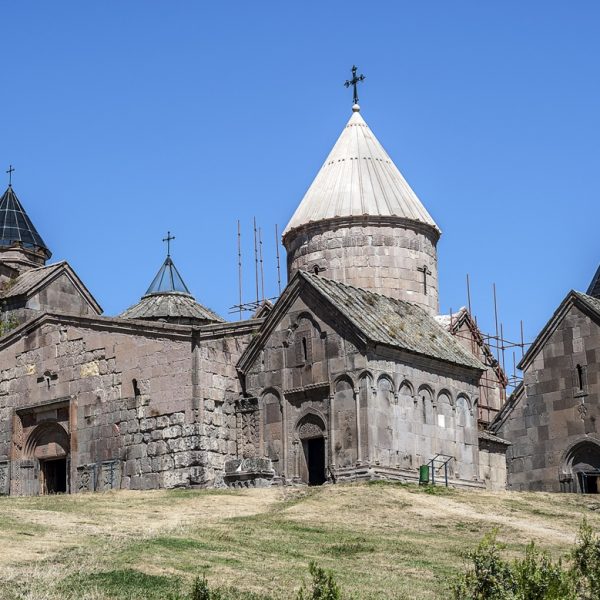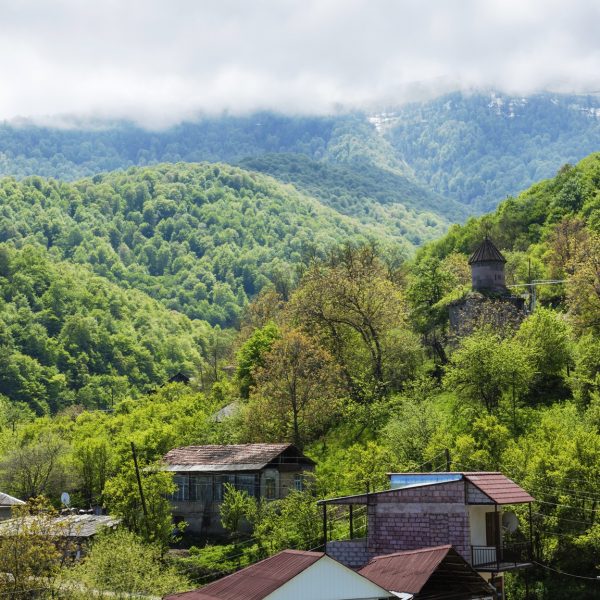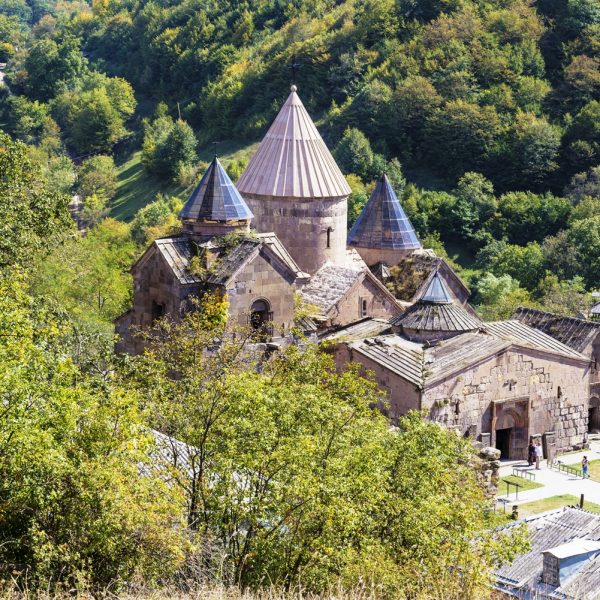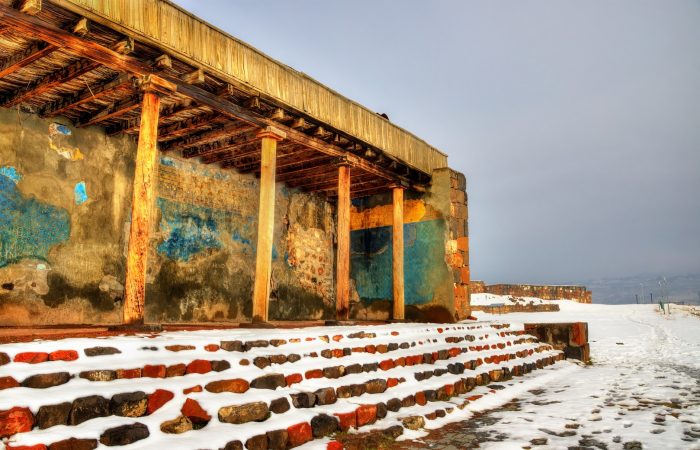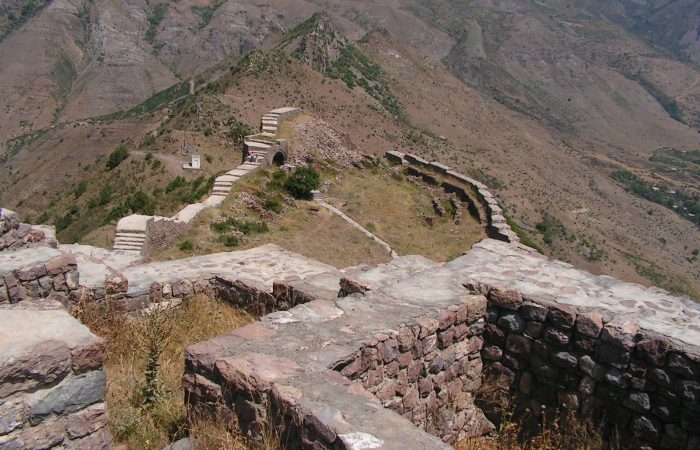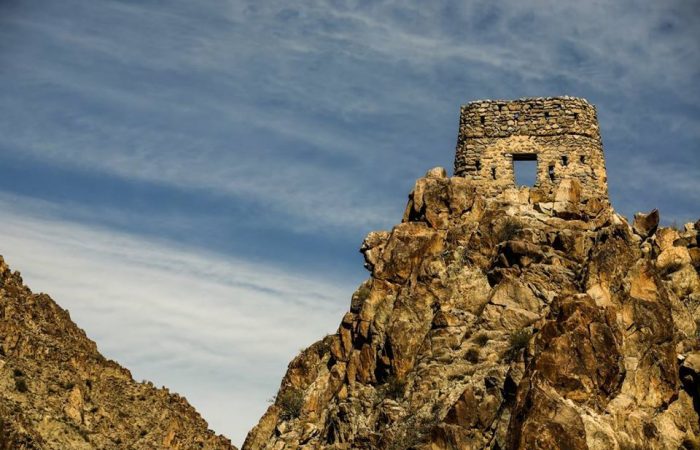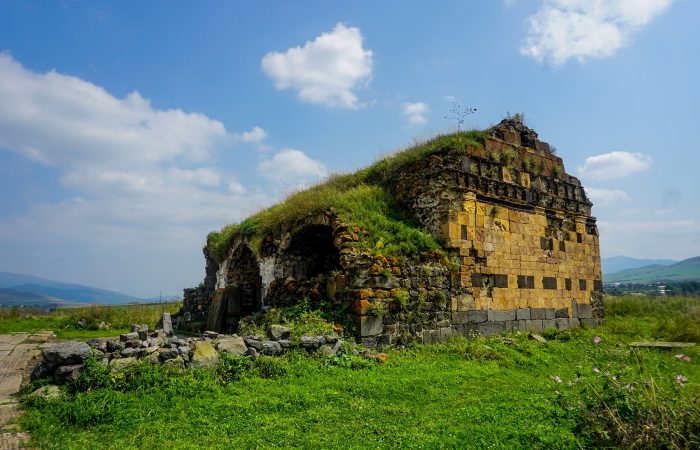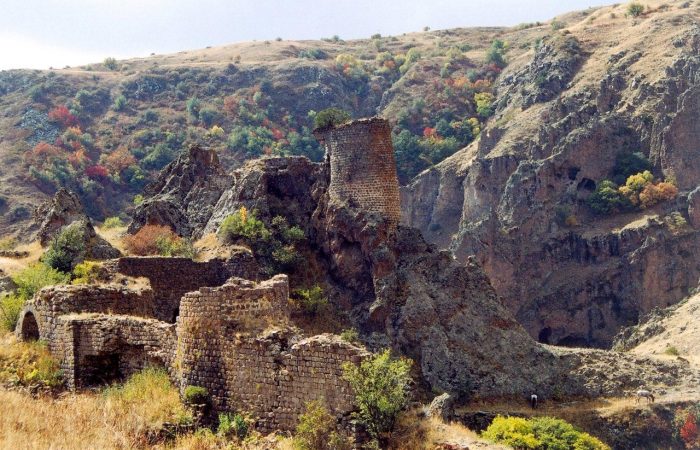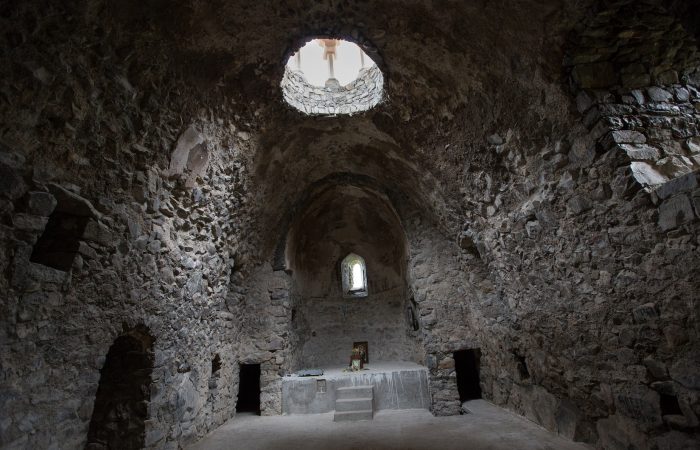Goshavank Monastery: Surb Grigor Lusavorich Church
The construction of the Surb Grigor Lusavorich (Saint Gregory the Illuminator) Church was launched in 1237 and was completed in 1241. It was ordered by Prince Grigor Tgha (tgha means boy in English), the grandson of the Prince Vakhtang of Haterk. Grigor was adopted by the Zakaryans when still a kid and was therefore nicknamed Tgha (boy).
Despite its small sizes, Surb Grigor Lusavorich Church stands out. It is a single nave church with unique windows on eastern and western walls. The church’s arches make the church appear larger and taller than it actually is. The interior is very impressive. The altar is decorated with arches and geometric patterns.
Goshavank Monastery: Poghos Khatchkars (Cross-Stones)
The khatchkars carved by master carver Poghos have their unique place in khatchkar art. Two of his best works were placed at both sides of the western entrance of the Grigor Lusavorich Church.
One of the khatchkars was later (1935) transferred to Armenian History Museum and was included in the museum’s permanent exhibition. The remaining khatchkar was erected in 1291. It’s a real masterpiece worth every admiration. The lace patterns on the surface of the khatchkar do not repeat. Above the base-stone the Tree of life can be found, while at the bottom the author’s name is carved.
Another khatchkar is placed at Mkhitar Gosh’s crypt.
Goshavank Monastery: Gavit
A four column gavit was added in 1197-1203. In the center of the roof an eight-sided dome was erected. The gavit’s construction was funded by Zakaryan brothers. The architect was Mkhitar Hyusn (an inscription found on the gavit states that).
Goshavank Monastery: Saint Astvatsatsin Church
Being the monastery’s main church Saint Astvatsatsin church was built in 1191-1196 upon the financial assistance of Prince Vakhtang of Haterk (Artsakh) and his wife Arzukhatun. A description of Goshavank and the monastery’s benefactors was made by Kirakos Gandzaketsi, who used to study and work in Goshavank as well as was the author of the “History of Armenians.”
“A smaller church was also built at nor Getik. It was built in the name of Saint John the Baptist, who ordained Jesus Christ, the greatest born of a woman… It was built by Vardapet Mkhitar with his religious community and with the aid of Prince Vakhtang of Haterk and his brothers Grigor, Grigoris, Hoydan, Vasak and pious princes Kurd’s sons David and Sasun, their sister Arzukhatun (the wife of Vakhtang)… A dense crowd of people attended the opening of the church. The Bishop of Haghpat Hovhannes was also present there with a number of priests and clericals. The church was consecrated in the name of Saint Astvatsatsin (Holy Mother).”
The main entrance was added in 1197. Crosses and inscriptions are carved on the church walls. Also, on the western façade there is a sun dial.
Goshavank Monastery: Chapel-Auditorium
Since the 13th century a school used to function in Goshavank, which was mentioned as a school, university and seminary in historical sources. The school is thought to operate in the building, which served as both a chapel and an auditorium. It was built with gigantic and rough stones; such a structure was not much characteristic of that period. Armenian and foreign languages, grammar, philosophy, writing skills and other subjects were taught at the school. A number of prominent scientists and intellectuals used to study and work there. Among them were Kirakos Gandzaketsi and Vardan Areveltsi.
Goshavank Monastery: Scriptorium-Belfry
To the north of the gavit there is the monastery’s scriptorium-belfry. According to Kirakos Gandzaketsi, the belfry was built until 1241. In 1291, the second floor was added to the belfry; the architects were Grigor and Zakios. The scriptorium served as a library where manuscripts were being kept. It was also a scriptorium where manuscripts were being copied and new ones being created.
Goshavank Monastery: Saint Grigor Church
Saint Grigor Church (1208-1231) can be found south to the Saint Astvatsatsin Church and comes with an almost identical design. It was built after Mkhitar Gosh’s death by abbot Martiros and his brother Grigor. Possibly, Saint Grigor Church was built in the place of an older church, wooden-built John Baptist Church. According to historical sources, the construction of Saint Grigor Church was stopped because of the raids by Jalal-al-Din.
The church represents a domed hall. The initial building was ruined, and the current dome was erected in the 20th century emulating the original form.
Goshavank Monastery: Chapels
The chapels of Saint Hripsime and Saint Arakelots were built by Mkhitar Gosh in 1208. They lie between Saint Grigor Lusavorich and Saint Grigor churches. The two chapels come under the same roof. The chapel windows are made in a way as to let direct sunlight in.
Goshavank Monastery: Saint Gevorg Church
Saint Gevorg is a small domed church built by Vardapet Khachatur and Barsegh in 1254 at the mausoleum of Mkhitar Gosh. A legend has it the church was built in the place where Mkhitar Giosh spent the last days of his life leading an ascetic life, though until his death in 1203 he continued teaching and writing.
Goshavank Monastery: Mkhitar Gosh Mausoleum
To the west of Saint Gevorg Church, Mkhitar Gosh built chapel-mausoleum of Holy Ascension. He is buried there. Close to the mausoleum, he also built the Church of Holy Spirit, which however is not preserved. In his work “The History of Armenians” Kirakos Gandzaketsi wrote that “until today Mkhitar Gosh’s grave helps those sick people who take refuge in his prayers; soil from there is taken to cure sick people and animals because God glorifies those who glorify Him, in life and in death.”
Eventually, Goshavank monastery is truly a sacred place where you should step with a strong faith in God; that’s how people living and working there spent their life there, and that’s why the monastery has always been in the center of attention of not only Armenian people, but also foreigners.

